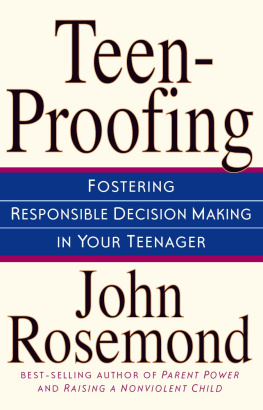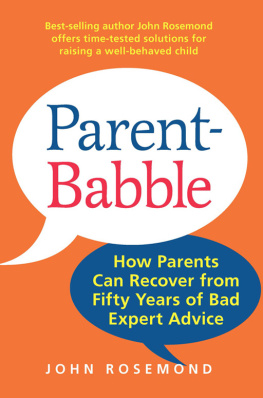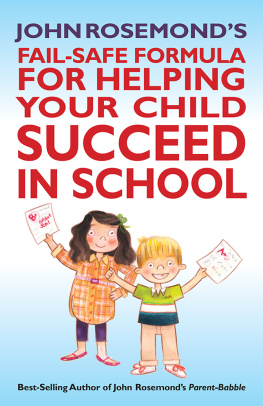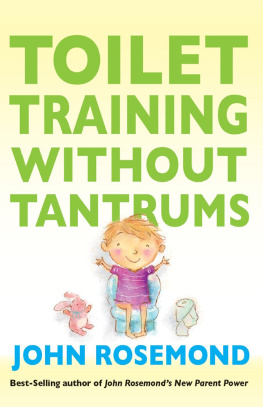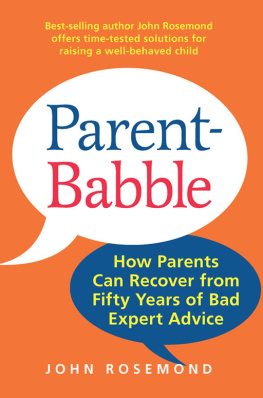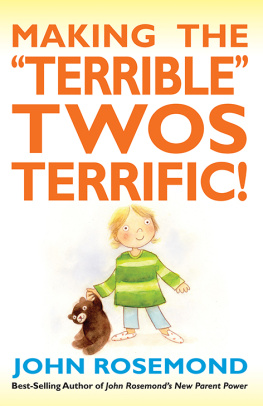O THER TITLES BY J OHN R OSEMOND
Because I Said So!
John Rosemonds Six-Point Plan for Raising Happy, Healthy Children
Parent Power! A Common Sense Approach to Raising Your Childrenin the Nineties and Beyond
Ending the Homework Hassle
Making the Terrible Twos Terrific!
To Spank Or Not to Spank
A Family of Value
(A BOVE TITLES PUBLISHED BY A NDREWS M C M EEL P UBLISHING )
John Rosemonds Daily Guide to Parenting
(P UBLISHED BY T HOUGHTFUL B OOKS /STA-K RIS , I NC .)
To my darlin Willie
Teen-Proofing: A Revolutionary Approach to Fostering Responsible Decision Making in Your Teenager copyright 2001 by John Rosemond. All rights reserved. No part of this book may be used or reproduced in any manner whatsoever without written permission except in the case of reprints in the context of reviews.
Andrews McMeel Publishing, LLC
an Andrews McMeel Universal company
1130 Walnut Street, Kansas City, Missouri 64106
www.andrewsmcmeel.com
A hardcover edition of this book was published in 1998 by Andrews McMeel Publishing
LIBRARY OF CONGRESS CATALOGING-IN-PUBLICATION DATA
As Cataloged for the Hardcover Edition
Rosemond, John K., 1947
Teen-proofing: a revolutionary approach to fostering responsible decision making in your teenager / John Rosemond.
p. cm.
E-ISBN: 9780740786761
1. Parent and teenagerUnited States. 2. Adolescent psychologyUnited States. 3. Child rearingUnited States. I. Title.
| HQ799.15.R57 1998 | 9827069 |
| 649'.125dc21 | CIP |
Designed by Kathryn Parise
Cover design by Tom McKeveny
ATTENTION:
SCHOOLS AND BUSINESSES Andrews McMeel books are available at quantity discounts withbulk purchase for educational, business, or sales promotionaluse. For information, please e-mail the Andrews McMeel PublishingSpecial Sales Department: |
C ONTENTS

T HANKS TO :
Everyone at Andrews McMeel, especially Donna Martin, Tom Thornton, and Katie Mace.
Everyone at The Center for Affirmative Parenting and Affirmative Parenting, Inc., especially Mary Cox, Marietta Dolman, Pam Fettig, Micki Fortner, Janet Moss, Mary Ellen Dillon, and Shannon (or is it Shayna?) Baxter.
Everyone at Hemispheres magazine, especially Randy Johnson and Lisa Fann, from Mr. Cantankerous, with a K.
Everyone at the Charlotte Observer, the Knight-Ridder wire, and the newspapers who continue to support my heresy by carrying my weekly column.
Dr. Bill Varley, for keeping me on the right track.
My supportive, loving, and most lovable wife of thirty years and getting better all the time, Willie.
My children, Eric and Amy, without whom I could not have written this book and because of whom I almost didn't.
I NTRODUCTION

Since 1955, two statistics concerning Americas teenagers have increased more than threefold:
1. violent crimesassaults on peers, teachers, parents, and society in general.
2. depressionas indicated by a tripling-plus of the teen suicide rate. (Statistics on teen depression from as far back as 1955 are highly unreliable, which leads some to assert that the threefold increase in teen depression is a function of more accurate reporting techniques. However, the teen suicide rate, concerning which fairly reliable records exist from 1955, and which is a marker of teen depression, has more than tripled since that time.)
Further, these increases have taken place across the demographic spectrum. In the 1950s, the kid who was likely to act out aggressively or develop serious emotional problems could be spotted a proverbial mile away. Almost always, he/she came from an obviously troubled family that lived on the wrong side of the tracks. As in: The mother had run off with a traveling salesman, leaving the children in the care of a father who was a frequently unemployed alcoholic. The kids were generally unsupervised, undisciplined, and did poorly in school. No one was surprised when the oldest child was sent to reform school at age fifteen for robbing a store, and everyone felt it was just a matter of time before the younger siblings developed serious antisocial behaviors as well.
In a little over one generation, teen problems that were once isolated to specific pockets of obvious socio-familial pathology have spilled out into every nook and cranny of our society. Today, the child who, as a teenager, develops serious problems might have grown up in an upscale neighborhood within an evidently healthy family that never misses church on Sunday.
Items: A fifteen-year-old Kentucky boy, shy, but with no obvious family or emotional problems, comes to school one day, pulls out a pistol, and shoots five of his classmates, killing two of them. Several months later, a similar incident happens in Arkansas, this time involving two fifth graders who methodically shoot four classmates and one teacher. Several months later in Mississippi, an eighth-grade boy approaches a teacher at a school function, puts a gun to the teachers head, and pulls the trigger.
Item: A fourteen-year-old boygood student, good athlete, lots of friendsfrom an upper-middle-class family that everyone in the community agrees is loving, hangs himself in the basement one day, leaving behind no note of explanation. This is not fiction, either. It concerns the child of a friend, who continues to be heartbroken and mystified.
That the above sorts of tragedies are becoming less and less the exception is nothing short of frightening. When I was a teenager, growing up in a middle-class Chicago suburb in the early- to mid-sixties, my peers and I were mischievous. We got away with what we could when adults werent looking. But todays teens arent just mischievous; rather, they have become downright dangerous, to themselves and others, and theres no way of knowing which teen is going to go off the deep end next.
Whats going on here? How does one explain why, in the worlds most successful country, children are so at risk for serious problems? Actually, I have an explanation, one that involves a fairly simple psychological axiom known as the flight or fight principle (FFP). Its one of the few psychological principles that has been documented to the point of no longer being considered theory, but fact. Like most valid psychological ideas (and they are few and far between, in my estimation), it states what is already common sense: When threatened by some thing or set of circumstances, an individual will either try to avoid the source of threat (flight) or aggress toward it (fight). In other words, threat causes some people, in some situations, to fleeto try and put distance between themselves and the source of threatwhile others try to suppress the source of threat through use of force. The actual response depends upon personality, situational, and historical variables, but in either case, the idea is to

